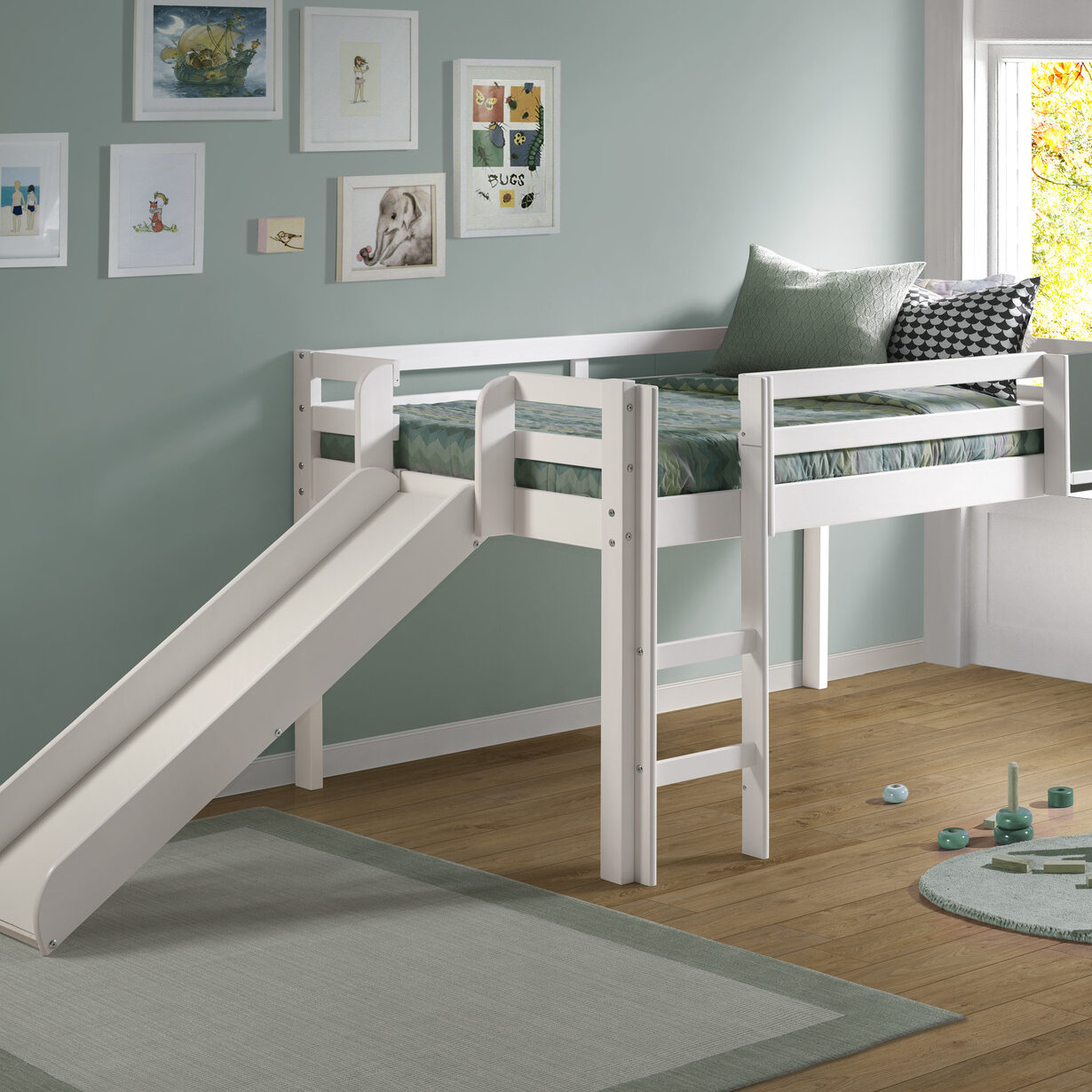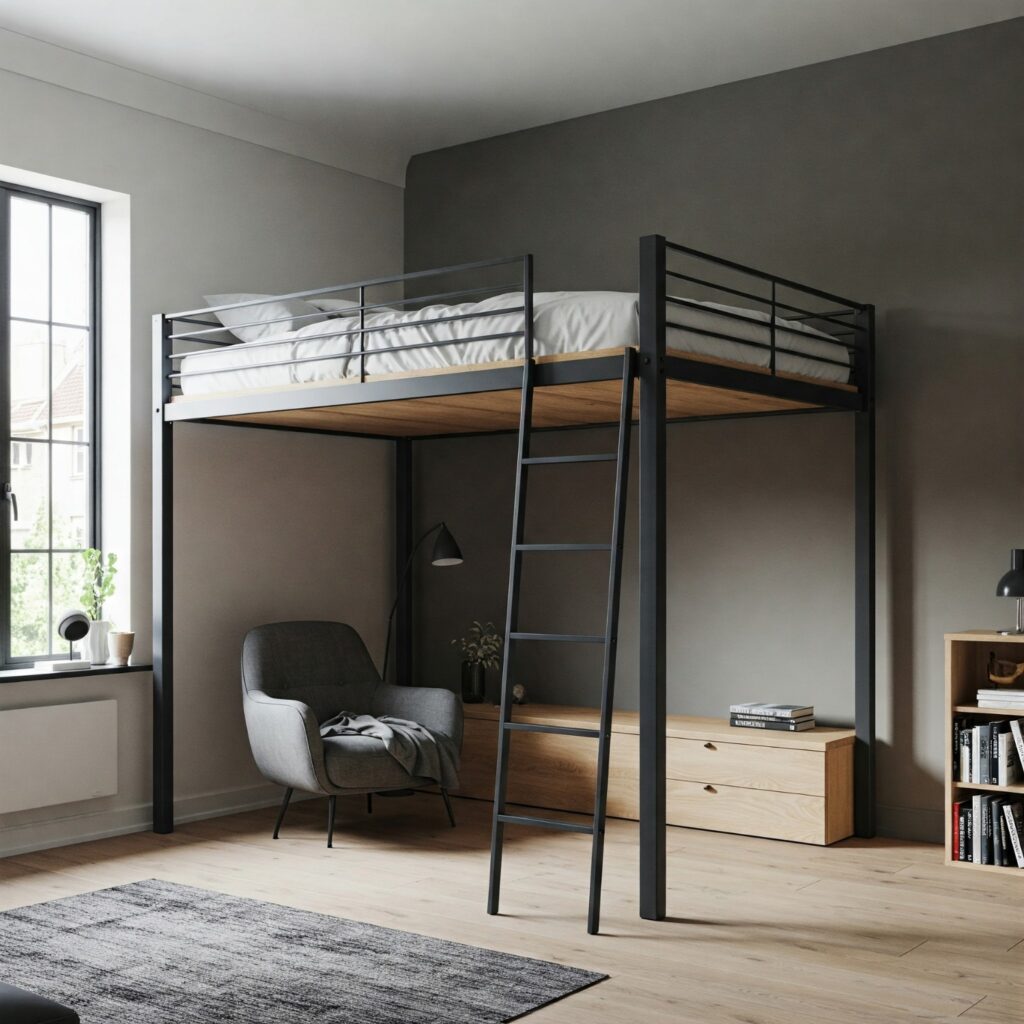
This comprehensive guide will walk you through everything you need to know to make an informed decision. We’ll explore safety considerations, space planning, material choices, styling trends for 2025, and creative ways to create a playful yet practical sleep area your child will love. Whether your child dreams of a whimsical treehouse loft or a sleek modern bunk, you’ll discover tips for selecting durable materials for children’s spaces and designing a bed that grows with your child.
Let’s dive into how to measure room dimensions for loft installations and uncover the key factors to create a safe, stylish, and highly functional space.
For more inspiration, check out 10 Stylish Loft Bed Ideas for Small Bedrooms in 2025!
1. Understanding Loft Beds: Benefits and Types
Benefits of Loft Beds
- Space-saving design: Ideal for small rooms.
- Multi-functional: Combines sleep, study, and play in one.
- Customizable: Styles range from modern to themed designs.
Popular Types of Loft Beds
- Standard Loft Bed: Bed on top, open space below.
- Study Loft: Desk and shelves underneath (like this one).
- Play Loft: Play space, slide, or reading nook beneath.
- Storage Loft: Built-in drawers, shelves, and cabinets.
2. Safety Features to Consider in Elevated Furniture
Essential Safety Considerations
- Sturdy frame: Choose solid wood or metal for durability.
- Guardrails: Ensure all sides have high, secure guardrails.
- Ladder safety: Non-slip steps, wide treads, and secure attachment.
Certifications to Look For
- ASTM or CPSC compliance: These certifications indicate the loft bed meets national safety standards for children’s furniture.
Additional Safety Tips
- Regularly check for loose screws or worn parts.
- Ensure the loft bed suits your child’s age — younger children may need lower bunk options.
- Keep the area around the loft bed clear to prevent falls.
3. How to Measure Room Dimensions for Loft Installations
Step-by-Step Guide
- Measure Ceiling Height: Loft beds need at least 30-36 inches of clearance above the mattress for safe headroom.
- Check Floor Space: Account for the bed footprint plus any accessories (desk, storage, etc.).
- Consider Access Points: Ensure ladders or stairs don’t block doors or windows.
- Account for Growing Needs: Plan space for future adjustments, such as adding a study area.
Pro Tip
Use painter’s tape to outline the bed’s dimensions on the floor to visualize how it fits.
4. Maximizing Usability with Multi-Functional Designs
Key Features
- Desk Underneath: Homework or creative space.
- Storage Drawers: Built into stairs or sides.
- Play Area: Soft seating, climbing walls, or mini tents.
Multi-Functional Layout Examples
- Sleep + Study: Loft bed with desk, shelves, and corkboard.
- Sleep + Play: Loft bed with slide, hammock chair, or toy storage.
- Sleep + Storage: Loft with wardrobe, bins, and hidden cubbies.
5. Creating a Playful Yet Practical Sleep Area
Fun Design Ideas
- Theme-Based Loft Beds:
- Castle-themed with turrets and flags.
- Space station with glow-in-the-dark stars.
- Jungle loft with hanging vines and animal prints.
Practical Elements
- Reading Nook: Bean bags, soft lighting, and shelves.
- Custom Curtains: Enclose the lower space for a fort-like feel.
- Climbing Features: Rock wall steps or rope ladders.
Balance Fun with Function
- Add removable elements so the loft can grow with your child.
6. Tips for Selecting Durable Materials for Children’s Spaces
Best Material Options
- Solid Wood: Long-lasting, easy to repair, customizable.
- Metal Frames: Lightweight, strong, modern aesthetic.
- Composite Woods: Budget-friendly, though less durable.
Key Considerations
- Non-Toxic Finishes: Water-based paints and stains.
- Scratch and Stain Resistance: Especially for younger kids.
- Easy to Clean: Choose materials that wipe down easily.
7. Styling Ideas for Different Themes and Tastes

Modern Minimalist
- Clean lines, neutral colors, integrated storage.
- Metal frame or light wood with matte finishes.
Rustic Charm
- Reclaimed wood frames, vintage accessories, cozy fabrics.
- Earth tones and warm lighting.
Whimsical and Playful
- Bold colors, fun shapes, themed accessories.
- Fairy lights, fabric canopies, personalized nameplates.
Eclectic Vibes
- Mix-and-match textures, global prints, artistic flair.
- Boho rugs, colorful throws, mismatched pillows.
8. Loft Bed Trends for 2025
Key Trends
- Sustainable Materials: Recycled woods, eco-friendly finishes.
- Smart Features: Built-in lighting, USB ports, adjustable components.
- Hybrid Spaces: Beds that transform into study or guest areas.
Innovative Accessories
- Clip-on shelves, modular storage units, themed wall decals.
9. Adapting Loft Beds for Different Room Sizes
Small Rooms
- Compact loft with integrated desk and shelves.
- Light colors to enhance visual space.
Shared Rooms
- Twin-over-loft layouts for siblings.
- Curtain dividers for privacy.
Large Rooms
- Oversized loft with lounge area underneath.
- Custom built-ins for personalized touches.
10. Final Tips for Long-Term Use and Adaptability
Future-Proofing Your Loft Bed
- Choose adjustable-height designs.
- Opt for modular units that can be reconfigured.
- Use neutral colors that adapt as your child’s tastes evolve.
Maintenance Tips
- Tighten bolts regularly.
- Use protective pads to prevent floor damage.
- Encourage kids to respect safety rules.
Conclusion:
Choosing the right loft bed for your child’s room goes beyond picking a style — it’s about creating a safe, functional, and inspiring environment that grows with your child. By considering safety features to consider in elevated furniture, how to measure room dimensions for loft installations, and tips for selecting durable materials for children’s spaces, you can confidently select a loft bed that balances fun and practicality.
From maximizing usability with multi-functional designs to creating a playful yet practical sleep area, the right loft bed transforms a child’s room into a versatile haven for sleep, study, and play. Whether you prefer a sleek modern setup or a whimsical adventure theme, 2025 trends offer plenty of inspiration for creative, functional loft bed designs.
Ready to create your child’s dream bedroom? Discover more Loft Bed styling tips and ideas on our blog and turn your vision into reality!
FAQ’s:
1. What age is appropriate for a loft bed?
Loft beds are generally recommended for children aged 6 and older. Younger children may have difficulty climbing ladders safely, so it’s important to consider your child’s motor skills and comfort level.
2. How much space do I need for a loft bed?
Measure your ceiling height to ensure at least 30-36 inches of clearance above the mattress for safe headroom. Also, factor in the bed’s footprint, including any attached desks, stairs, or storage units.
3. Are loft beds safe for kids?
Yes, when designed with safety features like sturdy frames, guardrails, and secure ladders. Look for beds that meet ASTM or CPSC safety standards and ensure proper assembly.
4. What are the best materials for a loft bed?
Solid wood and metal are the most durable choices. Wood offers a classic look and is easy to repair, while metal is lightweight and modern. Always choose non-toxic finishes for safety.
5. Can a loft bed be used in a shared room?
Absolutely! Loft beds work well in shared spaces by providing extra floor room for storage or study areas. Some models include twin-over-loft designs for multiple sleepers.

